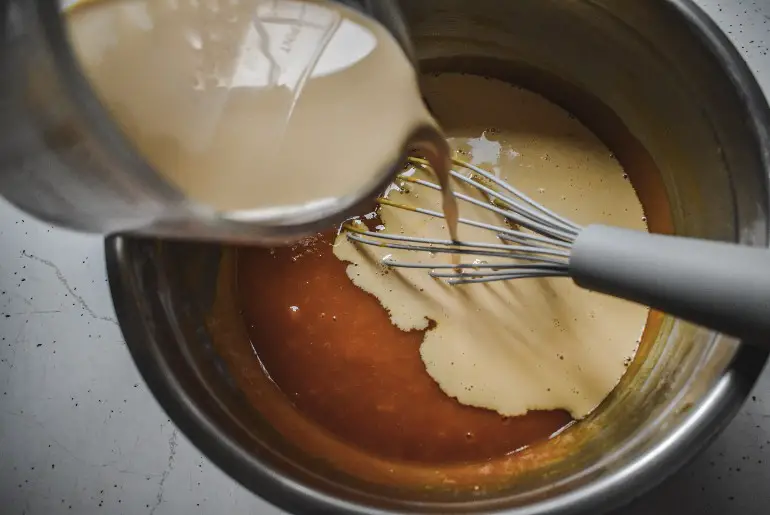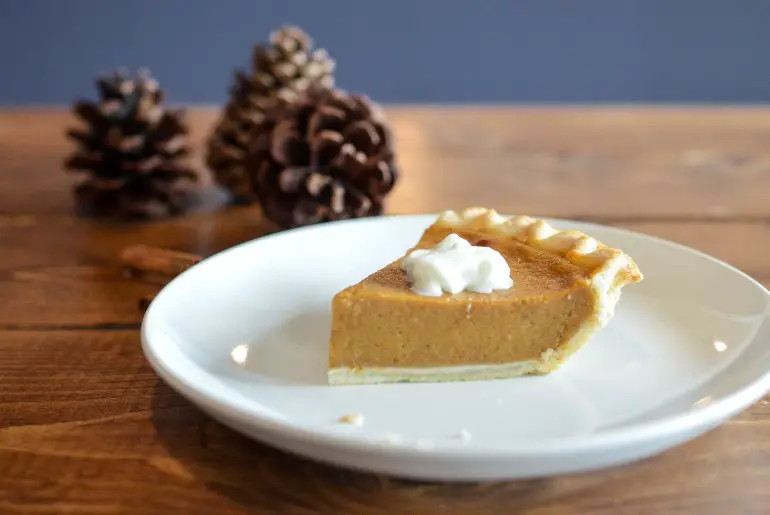As far as pies go, pumpkin pie is a pretty simple one. However, there are still plenty of pitfalls when making a pumpkin pie. So let’s go through some common concerns and what to do about them.
How To Know When Pumpkin Pie is Done
Your pie should look firm and set around the edges. The center should just have a little Jello-like jiggle. The pie shouldn’t be sloshy or wet looking.
When the pie looks done, insert a knife near the center of the pie. If it comes out clean, the pie is done.
Generally, you will bake pumpkin pie at a fairly low temperature (around 350°F). But my favorite pie recipe has you bake at 425°F for 15 minutes, then turn down the temperature to 350°F and bake for another 30 to 40 minutes (or until done).
1. Why Did My Pumpkin Pie Crack?
So why does your pumpkin pie crack? So pumpkin pie is a custard and is thickened by eggs. Protein is a coiled-up structure, and as the eggs cook, the protein unravels and coagulates (sets) so the custard to firms up and sets.
However, if the pie is cooked too quickly, at too high a temperature, or for too long, the proteins in the eggs will actually tighten up. This can squeeze out the moisture causing the pie to dry out and crack.
To prevent this from happening, watch your pumpkin pie closely for doneness. If your oven seems to run hot, you may want to start checking your pumpkin pie earlier than the recipe calls for.
2. Why Did My Pie Crust Burn on the Edges?
Your crust burns or gets brown before the pie is even cooked. The crust on the edges is much thinner and cooks more quickly than the rest of the pie. This can also happen if the oven is too hot or if the pie is too close to the top of the oven.
To prevent this, you can cook longer at a lower temperature, around 375°F generally. Baking in the lower third of your oven can also help. If you notice your crust is still getting too brown, you can use a pie crust protector or a circle of aluminum foil over the crust to keep it from getting too brown.

3. Why is My Pumpkin Pie Runny?
If your pumpkin pie is runny, it is likely due to being underbaked. If it is still warm, you can place it back in the oven and bake it longer until it is done. However, if you have put a knife in the center of the pie and it comes out clean, you may just need to give the pie a chance to cool fully.
Another possible issue is if you made a substitution, such as substituting the evaporated milk or the eggs. If you’re using regular milk or non-dairy milk instead of evaporated milk, you will need to add 2 to 3 tablespoons of cornstarch into your milk or milk substitute.
If the pumpkin you are using is watery, that can also cause a runny pie. To prevent this, strain the pumpkin using a cheesecloth or fine mesh strainer.
4. Why Did My Pumpkin Pie Sink?
If you bake your pie in too hot an oven, it can make the custard puff up too much. It will then fall when it cools. Your pie may also puff up too much if there are too many eggs, as the eggs are what make your pie puff up in the first place.
It can also happen if you cool the pie too quickly. Allow the pie to cool for 1 to 2 hours in your kitchen before placing it in the fridge. If you immediately place your pie in the fridge after pulling it from the oven, it can make the pie fall.
5. Why is My Pumpkin Pie Sweating?
This can happen if you place a warm pie in the fridge, as a hot pie in a cold fridge can cause condensation to form. It can also happen if there was too much moisture in the pie filling to begin with, usually caused by using watery pumpkin in your filling.
Another common cause is overbaking the pie. If you overbake your pie, the protein structure in the eggs sets too tightly, essentially squeezing out the moisture. This can cause beads of sticky liquid to form on your pie filling.
Make sure you closely watch your pie for doneness; you can tell your pie is done once you put a knife in the center and it comes out clean.

6. Why Does My Pumpkin Pie Have a Soggy Crust?
The most common cause of a soggy pie is a pie filling that is weeping. The liquid then sits on the crust and makes it soggy. As stated above, a weepy pie is caused by putting a hot pie in a cold fridge or by overbaking.
If your pie isn’t weeping, but you still feel like your pumpkin pies are turning out too soggy, try blind baking the crust.
This involved pre-baking your unfilled crust for 10 minutes (be sure to use dry beans or pie weights). Allow the crust to cool, then add the filling and finish baking. If you do this, you will want to use a crust protector or a ring of aluminum foil to cover the exposed crust and keep it from browning too much.
7. Why is My Pumpkin Pie Pulling Away From the Crust?
If your pumpkin pie filling is shrinking and pulling away from the crust, this is usually caused by overbaking. It can also be caused by putting the pie too close to the top of the oven. This can make it form a skin on the top; then, when it settles and cools, it pulls away from the crust.
To prevent this, bake in the lower third of the oven. Also, watch your pie to ensure it doesn’t overbake. Insert a knife in the center to see if it comes out clean in order to know if your pie is done.
8. Why is My Pumpkin Pie Shrinking, and the Crust Pulls Away from the Pan?
If your whole pie is shrinking and the crust is pulling away from the pie pan, then it is likely an issue with your crust. The most common cause is not allowing your pie dough to rest.
When making pie dough, shape it into a disc, wrap it in plastic wrap, and allow it to rest for 20 to 30 minutes in the fridge. Then once you have rolled out and put your crust into your pie pan, let it rest for another 10 to 15 minutes in the fridge.
9. Why is My Pumpkin Pie Filling Curdling?
This is another issue caused by overbaking. Baking at too high a heat or overbaking the pie can make the filling separate. It will get grainy, and a thick film usually forms on the top of the
Because pumpkin pie filling is a custard (made with eggs), it usually curdles once the temperature of the filling gets above 185°F. Generally, it is recommended to make sure pumpkin pie filling gets to 165F° to ensure that the eggs are fully cooked.
However, you will want to bake your pie at a lower temperature and watch it closely for doneness if your pumpkin pie tends to curdle. You can tell your pumpkin pie is done if a knife inserted in the center comes out clean.
If you’re looking for a reliable pumpkin pie recipe, I recommend my pumpkin pie from scratch. Happy baking!






